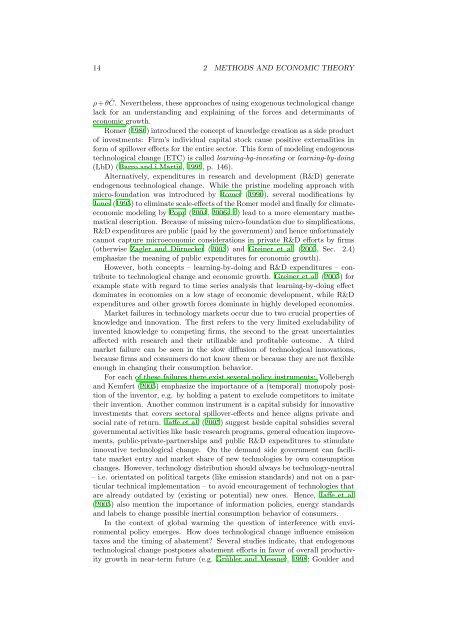Modeling Climate Policy Instruments in a Stackelberg Game with ...
Modeling Climate Policy Instruments in a Stackelberg Game with ...
Modeling Climate Policy Instruments in a Stackelberg Game with ...
You also want an ePaper? Increase the reach of your titles
YUMPU automatically turns print PDFs into web optimized ePapers that Google loves.
14 2 METHODS AND ECONOMIC THEORY<br />
ρ+θĈ. Nevertheless, these approaches of us<strong>in</strong>g exogenous technological change<br />
lack for an understand<strong>in</strong>g and expla<strong>in</strong><strong>in</strong>g of the forces and determ<strong>in</strong>ants of<br />
economic growth.<br />
Romer (1986) <strong>in</strong>troduced the concept of knowledge creation as a side product<br />
of <strong>in</strong>vestments: Firm’s <strong>in</strong>dividual capital stock cause positive externalities <strong>in</strong><br />
form of spillover effects for the entire sector. This form of model<strong>in</strong>g endogenous<br />
technological change (ETC) is called learn<strong>in</strong>g-by-<strong>in</strong>vest<strong>in</strong>g or learn<strong>in</strong>g-by-do<strong>in</strong>g<br />
(LbD) (Barro and i Mart<strong>in</strong>, 1999, p. 146).<br />
Alternatively, expenditures <strong>in</strong> research and development (R&D) generate<br />
endogenous technological change. While the prist<strong>in</strong>e model<strong>in</strong>g approach <strong>with</strong><br />
micro-foundation was <strong>in</strong>troduced by Romer (1990), several modifications by<br />
Jones (1995) to elim<strong>in</strong>ate scale-effects of the Romer model and f<strong>in</strong>ally for climateeconomic<br />
model<strong>in</strong>g by Popp (2004, 2006a,b) lead to a more elementary mathematical<br />
description. Because of miss<strong>in</strong>g micro-foundation due to simplifications,<br />
R&D expenditures are public (paid by the government) and hence unfortunately<br />
cannot capture microeconomic considerations <strong>in</strong> private R&D efforts by firms<br />
(otherwise Zagler and Dürnecker (2003) and Gre<strong>in</strong>er et al. (2005, Sec. 2.4)<br />
emphasize the mean<strong>in</strong>g of public expenditures for economic growth).<br />
However, both concepts – learn<strong>in</strong>g-by-do<strong>in</strong>g and R&D expenditures – contribute<br />
to technological change and economic growth. Gre<strong>in</strong>er et al. (2005) for<br />
example state <strong>with</strong> regard to time series analysis that learn<strong>in</strong>g-by-do<strong>in</strong>g effect<br />
dom<strong>in</strong>ates <strong>in</strong> economies on a low stage of economic development, while R&D<br />
expenditures and other growth forces dom<strong>in</strong>ate <strong>in</strong> highly developed economies.<br />
Market failures <strong>in</strong> technology markets occur due to two crucial properties of<br />
knowledge and <strong>in</strong>novation. The first refers to the very limited excludability of<br />
<strong>in</strong>vented knowledge to compet<strong>in</strong>g firms, the second to the great uncerta<strong>in</strong>ties<br />
affected <strong>with</strong> research and their utilizable and profitable outcome. A third<br />
market failure can be seen <strong>in</strong> the slow diffusion of technological <strong>in</strong>novations,<br />
because firms and consumers do not know them or because they are not flexible<br />
enough <strong>in</strong> chang<strong>in</strong>g their consumption behavior.<br />
For each of these failures there exist several policy <strong>in</strong>struments: Vollebergh<br />
and Kemfert (2005) emphasize the importance of a (temporal) monopoly position<br />
of the <strong>in</strong>ventor, e.g. by hold<strong>in</strong>g a patent to exclude competitors to imitate<br />
their <strong>in</strong>vention. Another common <strong>in</strong>strument is a capital subsidy for <strong>in</strong>novative<br />
<strong>in</strong>vestments that covers sectoral spillover-effects and hence aligns private and<br />
social rate of return. Jaffe et al. (2005) suggest beside capital subsidies several<br />
governmental activities like basic research programs, general education improvements,<br />
public-private-partnerships and public R&D expenditures to stimulate<br />
<strong>in</strong>novative technological change. On the demand side government can facilitate<br />
market entry and market share of new technologies by own consumption<br />
changes. However, technology distribution should always be technology-neutral<br />
– i.e. orientated on political targets (like emission standards) and not on a particular<br />
technical implementation – to avoid encouragement of technologies that<br />
are already outdated by (exist<strong>in</strong>g or potential) new ones. Hence, Jaffe et al.<br />
(2005) also mention the importance of <strong>in</strong>formation policies, energy standards<br />
and labels to change possible <strong>in</strong>ertial consumption behavior of consumers.<br />
In the context of global warm<strong>in</strong>g the question of <strong>in</strong>terference <strong>with</strong> environmental<br />
policy emerges. How does technological change <strong>in</strong>fluence emission<br />
taxes and the tim<strong>in</strong>g of abatement? Several studies <strong>in</strong>dicate, that endogenous<br />
technological change postpones abatement efforts <strong>in</strong> favor of overall productivity<br />
growth <strong>in</strong> near-term future (e.g. Grübler and Messner, 1998; Goulder and
















